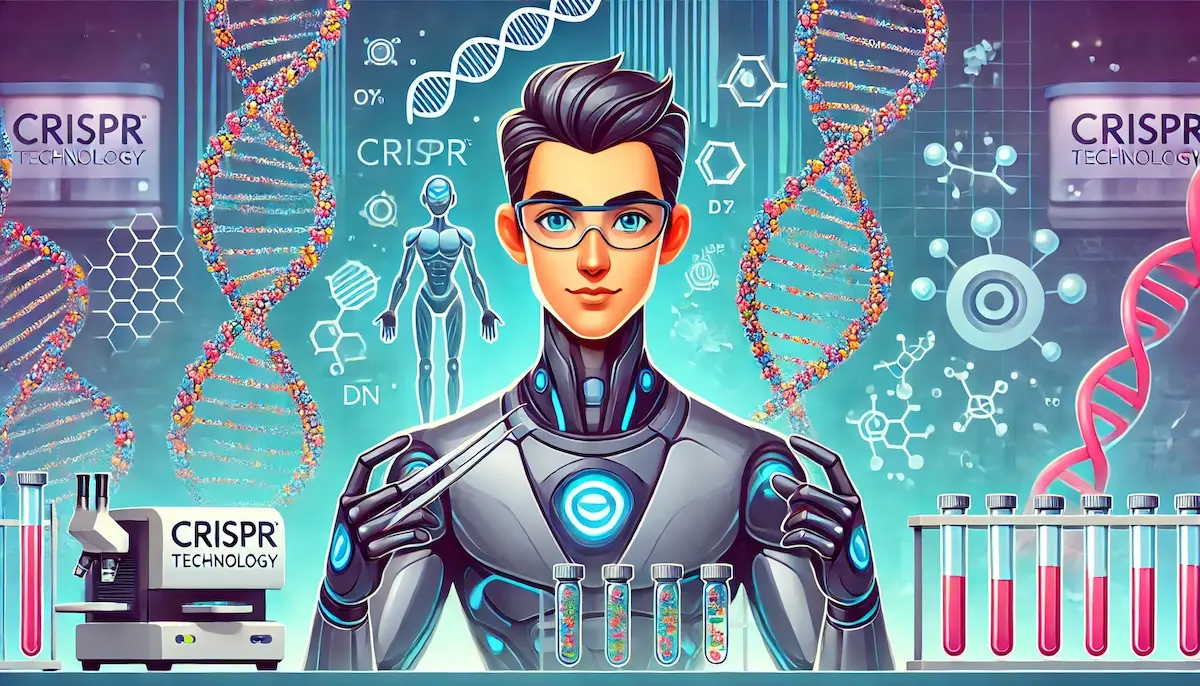CRISPR, an acronym for Clustered Regularly Interspaced Short Palindromic Repeats, is a groundbreaking technology in genetic engineering. It has revolutionized the field by allowing precise, targeted changes to DNA. CRISPR’s simplicity, efficiency, and versatility have made it a powerful tool for scientific research, medicine, and agriculture. Let’s explore what CRISPR is, how it works, and its transformative applications.
What is CRISPR?
CRISPR is a technology that enables scientists to edit genes by precisely cutting DNA and allowing natural DNA repair processes to introduce desired changes. It is based on a natural defense mechanism found in bacteria, which use CRISPR-associated proteins (Cas proteins) to defend against viruses by cutting their DNA.
How Does CRISPR Work?
The CRISPR-Cas9 System
The most widely used CRISPR system involves the Cas9 protein and a piece of RNA called the guide RNA (gRNA). Here’s how it works:
- Guide RNA (gRNA): A synthetic RNA molecule designed to match the DNA sequence of the target gene. The gRNA guides the Cas9 protein to the specific location in the genome where the edit is to be made.
- Cas9 Protein: An enzyme that cuts the DNA at the location specified by the gRNA. Cas9 acts as molecular scissors, creating a double-strand break in the DNA.
The Editing Process
- Design: Scientists design the gRNA to match the target DNA sequence.
- Delivery: The gRNA and Cas9 protein are introduced into the target cells.
- Binding: The gRNA binds to the target DNA sequence, guiding the Cas9 protein to the correct location.
- Cutting: Cas9 cuts both strands of the DNA at the target site.
- Repair: The cell’s natural repair mechanisms fix the break. Scientists can harness these repair processes to add, delete, or replace DNA sequences.
Repair Mechanisms
- Non-Homologous End Joining (NHEJ): A repair process that directly joins the broken DNA ends. This method is prone to errors and often results in small insertions or deletions, which can disrupt gene function.
- Homology-Directed Repair (HDR): A more precise repair process that uses a template to guide the repair. Scientists can provide a DNA template to introduce specific changes during the repair process.
Applications of CRISPR
Medicine
- Gene Therapy: CRISPR can be used to correct genetic mutations responsible for inherited diseases. For example, researchers are exploring CRISPR-based treatments for conditions like cystic fibrosis, sickle cell anemia, and muscular dystrophy.
- Cancer Treatment: CRISPR can modify immune cells to better recognize and attack cancer cells. CAR-T cell therapy, for example, uses CRISPR to enhance the ability of T cells to target tumors.
- Infectious Diseases: CRISPR can potentially be used to target and deactivate viral DNA, offering new approaches to treat viral infections like HIV and hepatitis.
Agriculture
- Crop Improvement: CRISPR can create crops with enhanced traits such as increased yield, drought tolerance, and disease resistance. For example, CRISPR has been used to develop rice varieties with higher resistance to bacterial blight and tomatoes with improved shelf life.
- Livestock: Genetic modifications in livestock can improve traits such as growth rate, disease resistance, and meat quality. CRISPR has been used to produce pigs resistant to certain viral infections and cattle with increased muscle mass.
Environmental Conservation
- Species Preservation: CRISPR can help preserve endangered species by correcting genetic defects or enhancing resistance to diseases.
- Invasive Species Control: CRISPR-based gene drives can spread specific genetic traits through populations of invasive species to reduce their numbers and mitigate environmental impact.
Research
- Functional Genomics: CRISPR allows scientists to study gene function by creating targeted mutations. This helps identify the roles of specific genes in health and disease.
- Model Organisms: Creating genetically modified model organisms to study human diseases, developmental biology, and genetics. CRISPR is used to produce animal models with precise genetic alterations for research purposes.
Benefits of CRISPR
Precision
CRISPR allows for highly specific targeting of genes, minimizing off-target effects and unwanted changes to the genome. This precision is crucial for applications in medicine and research where accuracy is paramount.
Efficiency
CRISPR is faster and more efficient than previous gene-editing methods. It simplifies the process of making genetic modifications, reducing the time and cost involved in genetic research and development.
Versatility
CRISPR can be applied to a wide range of organisms and cell types, making it a versatile tool for various scientific and medical applications. It has broad potential across different fields, from human health to agriculture and environmental science.
Accessibility
The relative simplicity and affordability of CRISPR have democratized gene editing, making it accessible to many laboratories and researchers worldwide. This widespread access accelerates scientific discovery and innovation.
Challenges and Ethical Considerations
Off-Target Effects
While CRISPR is highly precise, off-target effects—where unintended parts of the genome are edited—can still occur. Developing methods to minimize and detect these off-target effects is an ongoing area of research.
Ethical Issues
CRISPR raises significant ethical questions, particularly regarding human genetic modification. Issues such as germline editing (which affects future generations), designer babies, and genetic enhancements need careful consideration and regulation.
Regulatory Hurdles
The rapid advancement of CRISPR technology poses challenges for regulatory frameworks. Ensuring safety, efficacy, and ethical compliance requires robust regulations and oversight.
Public Perception
Public understanding and acceptance of CRISPR are critical for its adoption and application. Addressing misconceptions, educating the public, and engaging in transparent dialogue about the benefits and risks are essential.
Conclusion
CRISPR is a revolutionary technology with the potential to transform medicine, agriculture, and scientific research. Its precision, efficiency, and versatility make it a powerful tool for addressing some of the most pressing challenges in these fields. However, careful consideration of the ethical, safety, and regulatory issues is essential to ensure responsible and beneficial use of CRISPR.
Blockfine thanks you for reading and hopes you found this article helpful.
